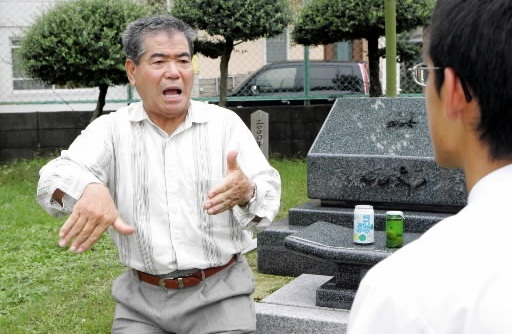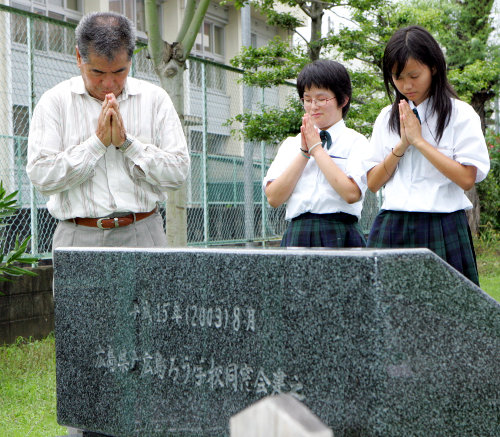The Silent Blast: The Atomic Bombing and the Deaf, Part 5
Jul. 1, 2010
Aging A-bomb survivor inspires monument to deaf victims
by Yoko Kinomoto and Kenichiro Nozaki, Staff Writers
The atomic bomb wrought unprecedented destruction 60 years ago. [This series was first published in July 2005.] But some of the residents of Hiroshima were unable to hear the tremendous blast. The bewildering devastation of the bombing was silently scored into the memories of deaf survivors. These survivors have lived their post-war days under a cloud of frustration, incapable of conveying verbally what they experienced. According to a group which recognizes the deaf victims of the atomic bomb, about 140 deaf people were exposed to the blast, but less than 50 are still alive today. The Chugoku Shimbun interviewed five deaf survivors through sign language interpreters to trace what they experienced on August 6, 1945 and in the bombing's aftermath.
Iwao Yoshigami, 71, a resident of Naka Ward, Hiroshima
Through a long investigation, Iwao Yoshigami learned in 2003 that 91 deaf people were killed in the atomic bombing of Hiroshima. Motivated by the wish of an older friend, he was able to identify the victims by visiting survivors in the deaf community. His findings have shed light on the long-forgotten deaf victims.
At a gathering of the elderly deaf held in Hiroshima in the fall of 1992, Chosuke Kakeya, then 90 years old and a close friend of Mr. Yoshigami's, implored him to erect a monument for the deaf victims of the atomic bombing. (Mr. Kakeya died in 1993.)
This was Mr. Kakeya's last request, so to speak, since he knew he did not have much time left. Mr. Kakeya, whose deaf wife was one of the A-bomb victims, said in his slow but impassioned sign language: "We need to pass down the tragedy and the fact that deaf people were among the victims." Mr. Yoshigami nodded earnestly.
It was not an easy task. There were no official documents and the circumstances surrounding the deaf at the time of the bombing were not clear. He had no idea how to go about raising funds for the project, either. It was for these same reasons that Mr. Kakeya and others had given up the idea of erecting a monument 45 years earlier, when other monuments were raised one after another along with the reconstruction of the city.
"I didn't know where to start," Mr. Yoshigami admitted. Despite feeling perplexed, he did not want to abandon the idea. Prior to the bombing, he had been evacuated to the town of Yoshida (now, the city of Akitakata) in northern Hiroshima Prefecture. From there, he saw the mushroom cloud beyond the mountains. Six days later, he went back to his house in Naka Ward, Hiroshima. In the city, he saw a score of charred bodies. As someone who had encountered the horror of the bombing, though he was not directly exposed to the bomb but to its residual radiation in the aftermath, he believed it was his duty to fulfill the project.
A turning point came in 2001, when sign language interpreter Fumie Nakagawa, 65, learned about Mr. Yoshigami's efforts and offered her support. With her help in communication and negotiations, a group for commemorating the deaf victims was established. Members of the group visited the households of deaf survivors, one by one, and gleaned information from those who held the Atomic Bomb Survivor's Certificate. Funds were raised through sign language circles and other avenues.
Forty-nine people holding the certificate provided information about the circumstances at the time of the bombing and their later lives. In addition to the bombing itself, it seemed that many of them were forced to endure greater suffering than other survivors due to their hearing disability. Hardships resulted from a lack of information, indigence, and limited communication with the people around them, to name a few.
Not a few deaf survivors failed to obtain the certificate. Some could not locate the necessary information from the city government because of their limited reading ability. In addition, there were not enough sign language interpreters to help them find witnesses to verify that they were exposed to the bomb. The range of jobs available to the deaf, such as woodworking and kimono sewing, were limited and often low-paying.
"Right after the war, many deaf people worked at social welfare facilities because they could not get jobs at ordinary businesses," Mr. Yoshigami said in a lecture about the war and the atomic bomb on July 11. The lecture was delivered in sign language at his old school, Hiroshima Prefectural School for the Deaf in Naka Ward. He talked about the lives of the deaf in those days as well as the atomic bombing. He hoped to communicate to students that the improvement of social welfare policies is only possible in a peaceful society.
The monument was erected on the grounds of the school in August 2003. Mr. Yoshigami feels that the monument was completed because of the will of Mr. Kakeya. Mr. Yoshigami gives lectures and shares his experiences in sign language for filming upon request. He believes, "Young people will pick up the torch of our hope and expand the networks for creating a peaceful world."
After the lecture, Mr. Yoshigami and students prayed in front of the monument. In his mind, he asked Mr. Kakeya, "Have I fulfilled my duty?"
(Originally published on July 21, 2005)









